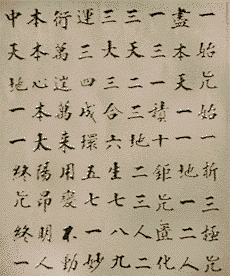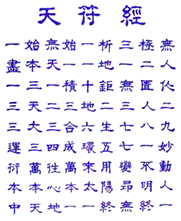Han & Samjae: Traditional Philosophy of Korea

You must have heard of Yin & Yang in the field of Oriental philosophy. But I guess, you may not have heard of Samjae or Han. Samjae can be declared to mean "Three kinds of essential materials", which are constituted of Sky, Earth and Man. The Chinese people didn't discussed of Samjae much, because they didn't understand of the significance of this conception without philosophical tradition of talking of them. Of course, Japanese philosophy, which have been mainly under the influence of Korean and Chinese philosophy, has nothing of discussing them either. You may be able to guess China, Korea and Japan have been influencing one another in almost every cultural aspects, which is natural considering their geographical locations. But it is somewhat extraordinary that only Korea has much bibliography of discussion on Samjae.
The central text on Samjae is Cheon-Bu Kyeong(bible given by heaven: The image of right part shows the bible.). This text is constitutied of only 81 Chinese letters. (Chinese letter have been the shared letters in Oriental area, so it is not extraordinary that this Korean text were written in Chinese letters). Originally, Cheon-Bu Kyeong was written in Nok-du letters, which was the unique Korean letters, but a scholar Choi, Chi-Won translated it into Chinese letters, and the original text have been lost so far. Around this bible, some more commentaries have been handed down so far in the Great Religion(Korean Traditional Religion believing Tangun). Those text will be quoted in the text of On Samjae and Kang-Yu. Though almost nobody talked of Samjae focusing its philosophical implication out of Korean philosophy, it is certain that this concept is very important in Oriental philosophy general. You may know I Ching, the book of Change. This book contains 64 hexagrams displaying implicit meanings of general change in man's life. Each hexagram is composed of two Kwae(Trigram)s, each of which is again composed of three yin or yangs. The reason why three yins or yangs constitute each Kwae is that each yin or yang follows the way of Samjae, Sky, Earth and Man. This reveals that the philosophy of yin/yang is based on the concept of Samjae. Then, what is the reason they didn't talk of Samjae? All of Korean inherited texts tell us that it is due to the fact that the main concept of Samjae belongs to Korean philosophical tradition.
The philosophy of Samjae can be said to be the harmony of One and Three. This one is called "Han." The Han has complex implications; not only of oneness but also of manyness or of muchness. To explain the essence of this conception, I'd like to say, everything is based on one thing, which, however, cannot be said of when it is absolute one, so we have to analyze the ontological foundation into three concepts of Sky, Earth and Man: The Samjae. If you are interested in more detailed desciption, refer to "The Metaphysic of TaekwondoBible.com".
Let me introduce of the meaning of Cheon Bu Kyeong translated into English.
<
Oneness and nothingness are born with each other. Divided into Three, which produce boundless change without exhausting its origin. The one Heaven is one, the one Earth is two, and the one Man is three. Accumulating those onenesses to be big ten, never-ending change is caused by those Three. The Heaven when two is three, the Earth when two is three, and the Man when two is three too. These big Three make Six, producing Seven, Eight, and Nine. Through Three and Four it makes a ring by Five and Seven. Since this One is profound and mysterious, coming and going innumerably, its use changes while its root never changes. Intrinsically the mind is root of everything, when looking up the bright sun, so the Heaven and the Earth make one in Man. Oneness and nothingness finish with each other.
The detailed and reasonable intepretation of this bible, the relation of Taekwondo principles and implications of this text's implication and so on will be some of the main theses of "The Philosophical Foundation of TKD Principles"(In http://taekwondobible.com).
Refer to: (my homepage)
http://taekwondobible.com/korculture/spirit/samjae.html

